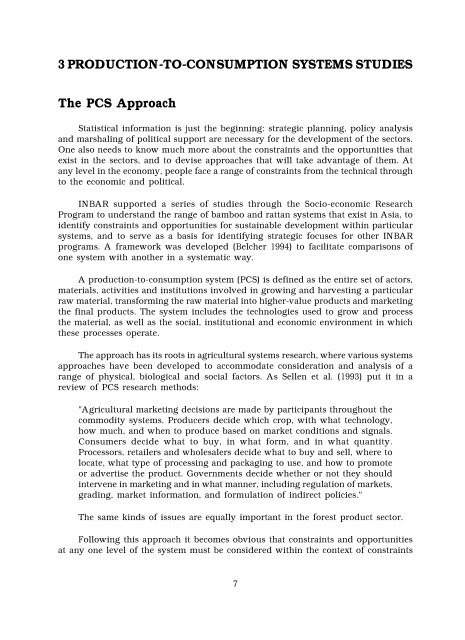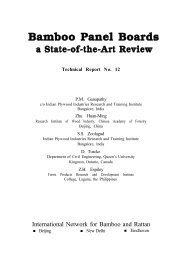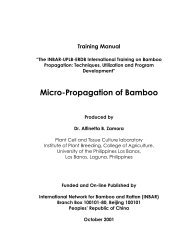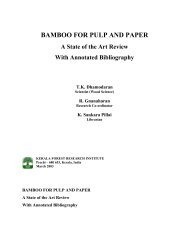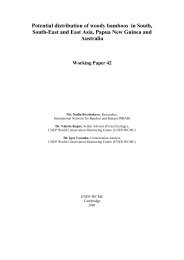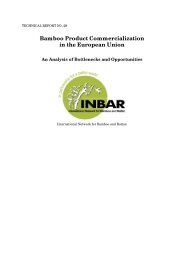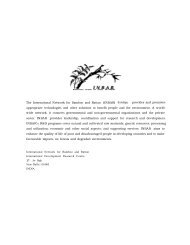The Bamboo and Rattan Sectors in Asia: an Analysis of ... - INBAR
The Bamboo and Rattan Sectors in Asia: an Analysis of ... - INBAR
The Bamboo and Rattan Sectors in Asia: an Analysis of ... - INBAR
You also want an ePaper? Increase the reach of your titles
YUMPU automatically turns print PDFs into web optimized ePapers that Google loves.
3 PRODUCTION-TO-CONSUMPTION SYSTEMS STUDIES<br />
<strong>The</strong> PCS Approach<br />
Statistical <strong>in</strong>formation is just the beg<strong>in</strong>n<strong>in</strong>g: strategic pl<strong>an</strong>n<strong>in</strong>g, policy <strong>an</strong>alysis<br />
<strong><strong>an</strong>d</strong> marshal<strong>in</strong>g <strong>of</strong> political support are necessary for the development <strong>of</strong> the sectors.<br />
One also needs to know much more about the constra<strong>in</strong>ts <strong><strong>an</strong>d</strong> the opportunities that<br />
exist <strong>in</strong> the sectors, <strong><strong>an</strong>d</strong> to devise approaches that will take adv<strong>an</strong>tage <strong>of</strong> them. At<br />
<strong>an</strong>y level <strong>in</strong> the economy, people face a r<strong>an</strong>ge <strong>of</strong> constra<strong>in</strong>ts from the technical through<br />
to the economic <strong><strong>an</strong>d</strong> political.<br />
<strong>INBAR</strong> supported a series <strong>of</strong> studies through the Socio-economic Research<br />
Program to underst<strong><strong>an</strong>d</strong> the r<strong>an</strong>ge <strong>of</strong> bamboo <strong><strong>an</strong>d</strong> ratt<strong>an</strong> systems that exist <strong>in</strong> <strong>Asia</strong>, to<br />
identify constra<strong>in</strong>ts <strong><strong>an</strong>d</strong> opportunities for susta<strong>in</strong>able development with<strong>in</strong> particular<br />
systems, <strong><strong>an</strong>d</strong> to serve as a basis for identify<strong>in</strong>g strategic focuses for other <strong>INBAR</strong><br />
programs. A framework was developed (Belcher 1994) to facilitate comparisons <strong>of</strong><br />
one system with <strong>an</strong>other <strong>in</strong> a systematic way.<br />
A production-to-consumption system (PCS) is def<strong>in</strong>ed as the entire set <strong>of</strong> actors,<br />
materials, activities <strong><strong>an</strong>d</strong> <strong>in</strong>stitutions <strong>in</strong>volved <strong>in</strong> grow<strong>in</strong>g <strong><strong>an</strong>d</strong> harvest<strong>in</strong>g a particular<br />
raw material, tr<strong>an</strong>sform<strong>in</strong>g the raw material <strong>in</strong>to higher-value products <strong><strong>an</strong>d</strong> market<strong>in</strong>g<br />
the f<strong>in</strong>al products. <strong>The</strong> system <strong>in</strong>cludes the technologies used to grow <strong><strong>an</strong>d</strong> process<br />
the material, as well as the social, <strong>in</strong>stitutional <strong><strong>an</strong>d</strong> economic environment <strong>in</strong> which<br />
these processes operate.<br />
<strong>The</strong> approach has its roots <strong>in</strong> agricultural systems research, where various systems<br />
approaches have been developed to accommodate consideration <strong><strong>an</strong>d</strong> <strong>an</strong>alysis <strong>of</strong> a<br />
r<strong>an</strong>ge <strong>of</strong> physical, biological <strong><strong>an</strong>d</strong> social factors. As Sellen et al. (1993) put it <strong>in</strong> a<br />
review <strong>of</strong> PCS research methods:<br />
"Agricultural market<strong>in</strong>g decisions are made by particip<strong>an</strong>ts throughout the<br />
commodity systems. Producers decide which crop, with what technology,<br />
how much, <strong><strong>an</strong>d</strong> when to produce based on market conditions <strong><strong>an</strong>d</strong> signals.<br />
Consumers decide what to buy, <strong>in</strong> what form, <strong><strong>an</strong>d</strong> <strong>in</strong> what qu<strong>an</strong>tity.<br />
Processors, retailers <strong><strong>an</strong>d</strong> wholesalers decide what to buy <strong><strong>an</strong>d</strong> sell, where to<br />
locate, what type <strong>of</strong> process<strong>in</strong>g <strong><strong>an</strong>d</strong> packag<strong>in</strong>g to use, <strong><strong>an</strong>d</strong> how to promote<br />
or advertise the product. Governments decide whether or not they should<br />
<strong>in</strong>tervene <strong>in</strong> market<strong>in</strong>g <strong><strong>an</strong>d</strong> <strong>in</strong> what m<strong>an</strong>ner, <strong>in</strong>clud<strong>in</strong>g regulation <strong>of</strong> markets,<br />
grad<strong>in</strong>g, market <strong>in</strong>formation, <strong><strong>an</strong>d</strong> formulation <strong>of</strong> <strong>in</strong>direct policies."<br />
<strong>The</strong> same k<strong>in</strong>ds <strong>of</strong> issues are equally import<strong>an</strong>t <strong>in</strong> the forest product sector.<br />
Follow<strong>in</strong>g this approach it becomes obvious that constra<strong>in</strong>ts <strong><strong>an</strong>d</strong> opportunities<br />
at <strong>an</strong>y one level <strong>of</strong> the system must be considered with<strong>in</strong> the context <strong>of</strong> constra<strong>in</strong>ts<br />
7


